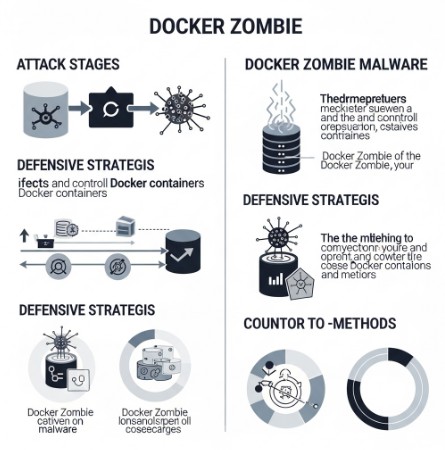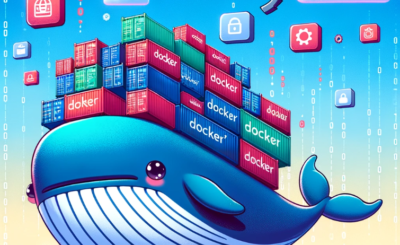The containerization revolution, spearheaded by Docker, has transformed software development and deployment. However, this technological advancement isn’t without its vulnerabilities. A particularly insidious threat emerging in this landscape is Docker Zombie Malware. This malware leverages the inherent characteristics of Docker containers to persist, spread, and remain undetected, posing a significant risk to system security and stability. This comprehensive guide will delve into the intricacies of Docker Zombie Malware, exploring its mechanisms, detection methods, and mitigation strategies to help you safeguard your containerized environments.
Table of Contents
- 1 Understanding the Mechanics of Docker Zombie Malware
- 2 Detecting Docker Zombie Malware: A Multi-Layered Approach
- 3 Mitigating the Threat of Docker Zombie Malware
- 4 Docker Zombie Malware: Advanced Detection Techniques
- 5 Frequently Asked Questions
- 5.1 What are the common symptoms of a Docker Zombie Malware infection?
- 5.2 How can I prevent Docker Zombie Malware from infecting my system?
- 5.3 What should I do if I suspect a Docker Zombie Malware infection?
- 5.4 Are there any tools specifically designed for Docker security?
- 5.5 How often should I scan my Docker images for vulnerabilities?
- 6 Conclusion
Understanding the Mechanics of Docker Zombie Malware
Docker Zombie Malware, unlike traditional malware, doesn’t necessarily aim for immediate destructive actions. Instead, it focuses on establishing a persistent presence within the Docker ecosystem, often acting as a covert backdoor for future malicious activity. This stealthy approach makes detection challenging.
How Docker Zombies Operate
- Exploiting Vulnerabilities: Many Docker Zombie Malware infections begin by exploiting vulnerabilities in the Docker daemon, Docker images, or host operating system. This allows the malware to gain initial access and establish itself.
- Container Injection: Once inside, the malware can inject itself into existing containers or create new, compromised containers. These containers might appear legitimate, masking the malicious activity within.
- Persistence Mechanisms: The malware uses various techniques to ensure persistence, including modifying Docker configuration files, leveraging cron jobs or systemd services, and embedding itself within Docker image layers.
- Network Communication: Compromised containers often establish covert communication channels with command-and-control (C&C) servers, enabling the attacker to remotely control the infected system and download further payloads.
- Data Exfiltration: Docker Zombie Malware can be used to steal sensitive data stored within containers or on the host system. This data might include source code, credentials, and other confidential information.
Types of Docker Zombie Malware
While specific malware strains vary, they share common characteristics. They might:
- Create hidden containers: Using obfuscation techniques to make their presence hard to detect.
- Modify existing images: Secretly injecting malicious code into legitimate images.
- Leverage rootkits: To further hide their activities and evade detection by security tools.
Detecting Docker Zombie Malware: A Multi-Layered Approach
Detecting Docker Zombie Malware requires a proactive and multi-layered approach.
Regular Security Audits
Regularly audit your Docker environment for suspicious activity. This includes:
- Inspecting running containers and their processes.
- Analyzing Docker logs for unusual network connections or file modifications.
- Reviewing Docker image metadata for potential malicious code.
Intrusion Detection Systems (IDS)
Implement an IDS specifically designed for containerized environments. These systems can monitor network traffic and system calls for malicious patterns indicative of Docker Zombie Malware.
Security Information and Event Management (SIEM)
A SIEM system can centralize security logs from various sources, including your Docker environment, enabling easier correlation of events and detection of suspicious activity.
Vulnerability Scanning
Regularly scan your Docker images and host systems for known vulnerabilities. Patching vulnerabilities promptly is crucial in preventing Docker Zombie Malware infections.
Mitigating the Threat of Docker Zombie Malware
A robust security posture is essential to combat Docker Zombie Malware.
Image Security Best Practices
- Use trusted image registries: Utilize official and reputable sources for Docker images to minimize the risk of compromised images.
- Regularly update images: Keep your Docker images up-to-date with the latest security patches.
- Image scanning: Employ automated image scanning tools to detect vulnerabilities and malware before deployment.
- Minimalist images: Use images with only the necessary components to reduce the attack surface.
Docker Daemon Hardening
Secure your Docker daemon by:
- Restricting access: Limit access to the Docker daemon to authorized users only.
- Using non-root users: Avoid running Docker as the root user.
- Enabling Docker content trust: Utilize Docker Content Trust to verify the integrity of images.
- Regular updates: Keep the Docker daemon updated with the latest security patches.
Network Security
Implement strong network security measures, including:
- Firewalls: Use firewalls to control network traffic to and from your Docker containers.
- Network segmentation: Isolate your Docker containers from other sensitive systems.
- Intrusion Prevention Systems (IPS): Deploy an IPS to actively block malicious traffic.
Docker Zombie Malware: Advanced Detection Techniques
Beyond basic detection, more advanced techniques are vital for identifying sophisticated Docker Zombie Malware. This requires a deeper understanding of container internals and system behavior.
Behavioral Analysis
Monitor container behavior for anomalies. This includes unexpected network activity, file modifications, or process executions. Machine learning can play a crucial role in identifying subtle deviations from normal behavior.
Memory Forensics
Analyze the memory of compromised containers to identify malicious code or processes that might be hidden in memory. This often requires specialized memory analysis tools.
Static and Dynamic Analysis
Perform static and dynamic analysis of Docker images to identify malicious code embedded within the image layers. Static analysis examines the image’s code without execution, while dynamic analysis monitors its behavior during execution.
Frequently Asked Questions
What are the common symptoms of a Docker Zombie Malware infection?
Common symptoms include unusual network activity from containers, unexpected resource consumption, slow performance, and unexplained changes to Docker configuration files. Also, be wary of any newly created containers you haven’t authorized.
How can I prevent Docker Zombie Malware from infecting my system?
Proactive measures are crucial. This includes using trusted images, regularly updating your Docker daemon and images, implementing strong access controls, and using security tools like IDS and SIEM systems.
What should I do if I suspect a Docker Zombie Malware infection?
Immediately isolate the affected system from your network. Conduct a thorough investigation, analyzing logs and using security tools to identify the malware. Consider engaging a security expert for assistance.
Are there any tools specifically designed for Docker security?
Yes, several tools are available to assist in Docker security, including Clair (for vulnerability scanning), Anchore Engine (for image analysis), and Sysdig (for container monitoring and security).
How often should I scan my Docker images for vulnerabilities?
Regular and frequent scanning is crucial. The frequency depends on how often you update your images and the sensitivity of your applications, but daily or at least weekly scanning is recommended.

Conclusion
Docker Zombie Malware presents a serious threat to the security and stability of containerized environments. By understanding its mechanisms, implementing robust security practices, and utilizing advanced detection techniques, you can significantly mitigate the risks associated with this insidious form of malware. Remember, proactive security is paramount in preventing and responding to Docker Zombie Malware infections. A layered security approach, combining best practices, regular audits, and advanced detection tools, is vital for maintaining a secure Docker environment. Thank you for reading the DevopsRoles page!
Docker Security Best Practices
What are containers?
Global Cybersecurity Market Report
